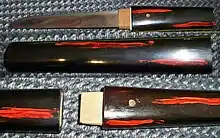Kaiken (dagger)
A kaiken (懐剣) is a 20–25 cm (7.9–9.8 in) long, single or (very rarely) double-edged Japanese knife[1] usually without ornamental fittings housed in a plain but lacquered mount.

Uses
The kaiken was once carried by men and women of the samurai class in Japan. It was useful for self-defense in indoor spaces where the long-bladed katana and intermediate-length wakizashi were inconvenient. Women carried them in their kimono either in a pocket-like space (futokoro) or in the sleeve pouch (tamoto)[2] for self-defense and for ritual suicide by slashing the veins in the left side of the neck.[3][4] When a samurai woman married, she was expected to carry a kaiken with her when she moved in with her husband.[5] The kaiken was also carried concealed in its shirasaya by the lower classes who were not permitted to wear swords, in particular by criminals in the Edo period.
In modern Japan, a kaiken is worn as a traditional accessory for the gyōji (referee) in sumo matches for the highest ranks. However, a real blade is not used. No one legally wears or carries a kaiken today in Japan, as this is a violation of the Gun and Sword Law. They can be legally transported, however, provided they are carried together with their registration certificate.
Orthography
Due to pronunciation changes over time, the blade's name has shifted from kwaiken to kaiken.[6] The kaiken is also referred to as a futokoro-gatana or a mamori-gatana (守り刀, 'protection sword/blade').
See also
References
- Stone, George Cameron (1999). Glossary of the Construction, Decoration and Use of Arms and Armor in All Countries and in All Times. Dover Publications. pp. 405–. ISBN 978-0-486-40726-5.
- Sinclaire, Clive (1 November 2004). Samurai: The Weapons and Spirit of the Japanese Warrior. Globe Pequot Press. pp. 88–. ISBN 978-1-59228-720-8.
- Tarassuk, Leonis; Blair, Claude (1982). The Complete encyclopedia of arms & weapons: the most comprehensive reference work ever published on arms and armour from prehistoric times to the present. Simon & Schuster. p. 306.
- Arai, Hakuseki; Joly, Henri L.; Inada, Hogitarō (1913). The Sword Book in "Honchō Gunkikō". C. E. Tuttle. p. 42.
- Mol, Serge (2003). Classical Weaponry of Japan: Special Weapons and Tactics of the Martial Arts. Kodansha International. pp. 27–. ISBN 978-4-7700-2941-6.
- Cannon, Garland Hampton; Warren, Nicholas W. (1996). The Japanese Contributions to the English Language: An Historical Dictionary. Otto Harrassowitz Verlag. pp. 65–. ISBN 978-3-447-03764-8.
External links
- Minoru, Nishio (1985) [1979]. Nishio Minoru; Iwabuchi Etsutarō; Mizutani Shizuo (eds.). Iwanami kokugo jiten (in Japanese) (3rd ed.). Tokyo: Iwanami Shoten. p. 155. ISBN 4-00-080003-5.
- Nihonto message board forum
- Richard Stein's Japanese sword guide
- Japan Arts Council e-book Mamori-gatana pp. 179–180